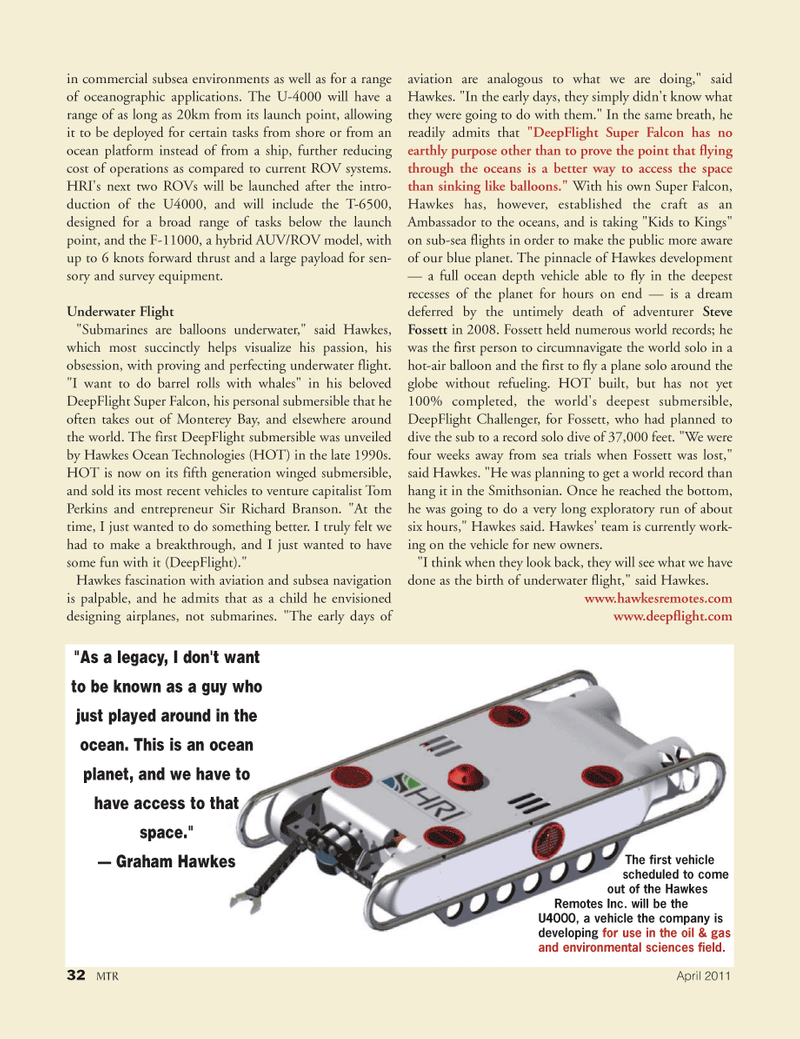
Page 32: of Marine Technology Magazine (April 2011)
Oil & Gas SubSea Monitoring
Read this page in Pdf, Flash or Html5 edition of April 2011 Marine Technology Magazine
in commercial subsea environments as well as for a range of oceanographic applications. The U-4000 will have a range of as long as 20km from its launch point, allowing it to be deployed for certain tasks from shore or from an ocean platform instead of from a ship, further reducing cost of operations as compared to current ROV systems.
HRI's next two ROVs will be launched after the intro- duction of the U4000, and will include the T-6500, designed for a broad range of tasks below the launch point, and the F-11000, a hybrid AUV/ROV model, with up to 6 knots forward thrust and a large payload for sen- sory and survey equipment.
Underwater Flight "Submarines are balloons underwater," said Hawkes, which most succinctly helps visualize his passion, his obsession, with proving and perfecting underwater flight. "I want to do barrel rolls with whales" in his beloved
DeepFlight Super Falcon, his personal submersible that he often takes out of Monterey Bay, and elsewhere around the world. The first DeepFlight submersible was unveiled by Hawkes Ocean Technologies (HOT) in the late 1990s.
HOT is now on its fifth generation winged submersible, and sold its most recent vehicles to venture capitalist Tom
Perkins and entrepreneur Sir Richard Branson. "At the time, I just wanted to do something better. I truly felt we had to make a breakthrough, and I just wanted to have some fun with it (DeepFlight)."
Hawkes fascination with aviation and subsea navigation is palpable, and he admits that as a child he envisioned designing airplanes, not submarines. "The early days of aviation are analogous to what we are doing," said
Hawkes. "In the early days, they simply didn't know what they were going to do with them." In the same breath, he readily admits that "DeepFlight Super Falcon has no earthly purpose other than to prove the point that flying through the oceans is a better way to access the space than sinking like balloons." With his own Super Falcon,
Hawkes has, however, established the craft as an
Ambassador to the oceans, and is taking "Kids to Kings" on sub-sea flights in order to make the public more aware of our blue planet. The pinnacle of Hawkes development — a full ocean depth vehicle able to fly in the deepest recesses of the planet for hours on end — is a dream deferred by the untimely death of adventurer Steve
Fossett in 2008. Fossett held numerous world records; he was the first person to circumnavigate the world solo in a hot-air balloon and the first to fly a plane solo around the globe without refueling. HOT built, but has not yet 100% completed, the world's deepest submersible,
DeepFlight Challenger, for Fossett, who had planned to dive the sub to a record solo dive of 37,000 feet. "We were four weeks away from sea trials when Fossett was lost," said Hawkes. "He was planning to get a world record than hang it in the Smithsonian. Once he reached the bottom, he was going to do a very long exploratory run of about six hours," Hawkes said. Hawkes' team is currently work- ing on the vehicle for new owners. "I think when they look back, they will see what we have done as the birth of underwater flight," said Hawkes. www.hawkesremotes.com www.deepflight.com
The first vehicle scheduled to come out of the Hawkes
Remotes Inc. will be the
U4000, a vehicle the company is developing for use in the oil & gas and environmental sciences field. "As a legacy, I don't want to be known as a guy who just played around in the ocean. This is an ocean planet, and we have to have access to that space." — Graham Hawkes 32 MTR April 2011

 31
31

 33
33
